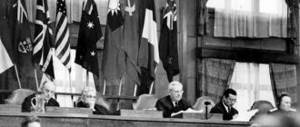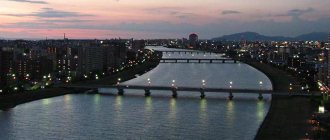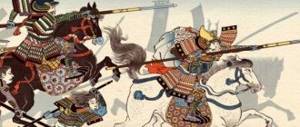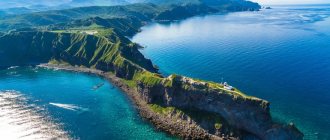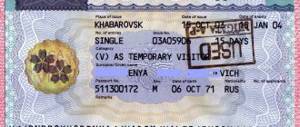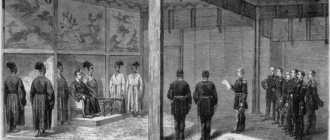Japan's participation in World War I is not a widely known historical fact. The West somehow forgot that the Japanese sided with the Allies against Germany, Austria-Hungary and the Ottoman Empire. The Imperial Japanese Navy fought German and Austrian submarines in the Mediterranean. This general amnesia can be explained by several factors.
Firstly, a little over 700 Japanese died in the battles of that war, while, for example, France lost more than 1.4 million of its soldiers. Second, Japan's aggression during World War II as an ally of Germany and Italy almost completely eclipsed Japan's involvement in the earlier war. Finally, the racial disdain of Western powers towards Asian countries in general and Japan in particular colored Western perceptions of events.
Organization and equipment of the army and navy
In 1914, the Japanese army consisted of 18 field divisions, each of which was organized in such a way that it could be deployed independently of the others and without reinforcements. The troops were equipped with modern weapons and equipment. The infantry boasted the Type 38 Arisaka marksman rifle. The basis of the artillery was formed from Krupp guns, produced in Japan under license.
In 1910, Captain Tokugawa Yoshitoshi made the first motorized biplane flight. However, the Army only showed significant interest in military aviation just before and during the First World War. The most important types of military aircraft came from the manufacturers Farman and Nieuport.
By 1914, the Imperial Navy was divided into three parts. The First Fleet consisted of modern battleships and cruisers under the command of Vice Admiral Kato Tomosaburo. The Second Fleet consisted of captured, old Russian ships and cruisers - its commander was Vice Admiral Kato Sadakichi. The third fleet was stationed in the South China Sea and consisted of cruisers. The most important anchorages for the flotillas were the ports of Yokosuka, Kure, Sasebo, Ominato and Maizuru.
The navy was still in its infancy, but Japanese admirals recognized the advantages of the aircraft, and in 1913 the transport ship Wakamiya was converted into a seaplane carrier. During maneuvers in the fall of 1913, several takeoffs were carried out from this ship, and by the beginning of 1914, the fleet already had ten such aircraft. On September 5, 1914, the first attack on German targets near Qingdao was carried out by seaplanes from Wakamiya.
The different strategic approaches and increased mechanization on the eve of the First World War did not yet pose insurmountable problems for the Japanese defense industry. It was not until the interwar period that disagreements between the army and navy led to a decline in weapons production and the depletion of the empire's limited resources.
external reference
- Melzer, Jurgen: War 1914-1918 (Japan), in: 1914-1918-online. International Encyclopedia of the First World War.
- Dickinson, Frederick R.: Civil and Military Power (Japan), in: 1914-1918-online. International Encyclopedia of the First World War.
- Dickinson, Frederick R.: Governments, Parliaments and Parties (Japan), in: 1914-1918-online. International Encyclopedia of the First World War.
- Schiltz, Michael: Wartime and Postwar Economy (Japan), in: 1914-1918-online. International Encyclopedia of the First World War.
- Sakamoto, Yuichiro: War Finance (Japan), in: 1914-1918-online. International Encyclopedia of the First World War.
Entering the war
Less than a week after the start of the war, Japan offered to join the Entente in exchange for German territories in the Far East and the Pacific Islands. When Britain asked for Japanese naval assistance in patrolling the eastern Pacific, Japan agreed, declaring war on Germany and Austria-Hungary on August 23, 1914. Thanks to Japanese patrols in the Pacific, the British Royal Navy was able to move more of its ships from the east to the Atlantic and Mediterranean, as well as strengthen the fleet at Scapa Flow, north of Scotland.
The Japanese also began to advance towards German possessions in China (especially the port city of Qingdao in the north) and German colonies in the Pacific Ocean, systematically occupying the Marianas, Caroline and Marshall Islands. Japan's successes raised concerns among both the Allies and the United States, which, although not involved in the war at the time, viewed the Japanese as a threat to its interests in the Pacific. In subsequent negotiations, a compromise was reached: Japan was allowed to occupy German territories north of the equator.
Militarization of the Japanese economy after World War I
1. The results of the First World War for Japan and its economy
The industrial revolution in Japan already in 1870-1880 was limited by the relative narrowness of the domestic market, so it tried in every possible way to capture foreign markets. In addition, the government was pushed to take such steps by the military ideology of the samurai nobles, who demanded expansion in the Far East and Southeast Asia under the slogan of expanding living space for Japan. The victory in the Russo-Japanese War only strengthened these sentiments in the country.
At the beginning of the 20th century, Japan was actively preparing for the redivision of the world, but it was not yet able to conduct any large-scale military operations on its own due to its insufficient economic development, therefore, with the beginning of the First World War, Japan joined the Entente, i.e. to a stronger military group. Since the main hostilities took place in Europe, no force could prevent Japan from easily capturing the German colonies: the Shantung Peninsula in China, the Marshall, Caroline and Mariana Islands in the Pacific Ocean (later, in 1919, the Treaty of Versailles legally secured these territories behind Japan, which was among the victorious countries).
In 1915, Japan presented China with the ultimatum document “21 demands,” which provided for the establishment of Japanese military and economic control over the main vital centers on Chinese territory: railways, ports, the most important military facilities, as well as industrial and commercial activities of China. In the same year, a Sino-Japanese treaty was concluded, the terms of which were especially oppressive for China.
During the same period, Japan continued to strengthen not only its military, but also its economic positions in China, Korea, and the countries of Southeast Asia. Japanese exports, for example, during the First World War increased almost fourfold, and capital exports to China almost fivefold. This led to the fact that Japan's trade and payments balance turned from passive to active: in 1918, the trade balance surplus was almost 300 million yen, and the payment balance was about 3 billion yen. The gold and foreign exchange reserves increased from 350 million yen on the eve of the war to more than 2 billion yen at the end of 1919.
When summing up the results of the First World War, in which Japan took little part, it achieved great advantages for itself. Thus, it received the right to have the same number of warships as the United States and England, as well as to create new naval bases on the Pacific islands. And this, in turn, encouraged the aggressive aspirations of the Japanese government in the Far East.
The active conquest of foreign markets and the growth of military orders led to the rapid development of industry. During the First World War, the total cost of industrial production (taking into account inflation) more than doubled, and the cost of metallurgy, mechanical engineering, and chemical products almost tripled. The fastest growing sector of the economy was shipbuilding: the tonnage of ships built in 1918 was eight times higher than in 1914. By the end of the war, Japanese shipbuilding had reached third place in the world.
Over the same years, the power supply of Japanese industry increased fourfold, and the number of workers employed in industrial production increased 1.6 times. The main economic result of the war years can be considered the transformation of Japan from an agrarian-industrial to an industrial-agrarian country. During the First World War, the largest companies, Mitsubishi, Sumitomo, Fuji, Yasuda, etc., received huge profits. The capital of joint stock companies increased 2.5 times.
But for the working masses, the war brought higher taxes and longer working hours. Rent in kind for land increased everywhere, sometimes reaching 60-70% of the rice harvest. A sharp increase in food prices (rice prices increased six times compared to pre-war levels) caused the so-called rice riots in August 1918, which lasted two months. In total, about 10 million people took part in these riots.
After the end of World War I, the Japanese economy faced a number of difficult problems. Thus, competition resumed in foreign markets between the leading world powers, with which Japan could not compete. In particular, the influence of large US corporations has again increased in China, forcing Japan to recognize the principle of “open doors” in trade with China, after which the Chinese market ceased to be the domain of Japan.
As a result, the Japanese economy suffered significant losses. During 1920-1921, Japanese exports decreased by 40%, imports by 30.9%, and the level of industrial production decreased by 20%. This decline in economic performance showed how fragile the effects of the war boom were.'
Japanese industrialists began to search for other options for economic development, which led to the revival and industrial expansion of 1924-1928. During this period, the production of iron and steel doubled. The share of industrial products in GDP was more than twice as high as agricultural products (7.7 and 3.5 billion yen, respectively). The formation of domestic mechanical engineering as a special industry has been completed. In light industry, the leading place was still occupied by factory production of cotton fabrics. By the end of the 1920s, the products of Japanese cotton enterprises could successfully compete with British goods on world markets.
1 One of the terrible trials that befell Japan was the earthquake of September 1, 1923 in the area of the cities of Tokyo and Yokohama. This disaster claimed the lives of 140 thousand people, material losses were estimated at 5 billion yen.
In the 1920s, the Japanese economy experienced a particularly rapid process of concentration of production and capital. In 1929, large enterprises
(50 or more employees) accounted for 61% of all industrial output. Enterprises employing over a thousand people employed 20% of Japanese workers. At the end of the 1920s, the 388 largest Japanese companies (with a capital of more than 10 million yen each) were almost equal in terms of capital concentration to the leading companies in Western countries.
During the First World War and in the first post-war years, the role of large associations in the form of family concerns - zaibatsu - increased significantly. But unlike Western corporations, these concerns were formed mainly not on the basis of market competition and concentration of capital, but through the use of special commercial and industrial privileges received from the state. Almost all zaibatsu were based on family, clan ties, which made them completely different from Western firms. The shares of such concerns were almost never sold on the open market, but were distributed among the founders of the companies and members of their families.
As a rule, all zaibatsu were multidisciplinary. Thus, the Mitsubishi concern in the 1920s controlled almost 120 companies with a total capital of 900 million yen. This zaibatsu included railway, electrical, shipbuilding, metallurgical, paper and other enterprises from various industries. The concerns Mitsui, Sumitomo, Yasuda and others were distinguished by the same versatility.
All zaibatsu were closely linked to the state, which continued to play a vital role in the economy, providing generous investment to companies. The state, in turn, owned many enterprises in mechanical engineering and shipbuilding, and controlled a significant part of foreign trade. The general level of development of state-owned enterprises was much higher than private ones. Among the country's largest owners was the Emperor of Japan himself: he owned shares in various companies worth 500 million yen. But the industrial boom of the 1920s also proved short-lived. Already at the end of 1929, Japan was drawn into a global economic crisis, which in 1931 led to a reduction in industrial output in value terms by a third, and exports by almost half; There were more than 10 million people in the country wholly or partially unemployed. The crisis most affected the shipbuilding, coal, metallurgical, and cotton industries.
The consequences of the crisis in the agricultural sector were especially severe. Due to falling prices, the total value of gross agricultural output fell from 3.5 billion yen in 1929 to 2 billion in 1931 (or more than 40%), which led to massive ruin among peasants, hunger among rural residents and worsening social contradictions in the village.
The reduction in exports has hit the traditional Japanese industry - sericulture - hard. While prices for agricultural products in general decreased by 47% over the years 1929-1931, prices for mulberry cocoons fell 3.5 times.
The ruling circles of Japan began to look for a way out of the difficult economic and political situation created for them during the years of crisis, primarily in preparing and unleashing a new war. A major step in this direction was the occupation of Northeast China (Manchuria) taken by the Japanese military in the fall of 1931, at the height of the crisis. The adventures of the Japanese military in Northeast China were accompanied by the reorganization and consolidation of the Japanese armed forces. The number of Japanese armed forces, which was 230 thousand before the invasion of Northeast China, increased to 380 thousand by 1936. Until 1931, the Japanese army was technically significantly inferior to the armies of other imperialist powers: the USA, England, France, etc. etc. The adoption by the ruling clique of Japan of a course to unleash a war in the Far East entailed a hasty modernization of the Japanese armed forces. During the period from 1931 to 1936, previously absent types of troops were created in the army, such as tank regiments, motorized mechanized units, and chemical battalions. The technical equipment of the army has increased significantly. By 1937, Japan, in terms of the saturation of its infantry divisions with artillery weapons, had almost caught up with England and the United States and surpassed France, and new types of guns were adopted in Japan's arsenal. From 1930 to 1936, the number of anti-aircraft guns in the Japanese army increased from 48 to 288, the number of tanks - from 120 to 1,000, and the number of aircraft - from 600 to 1,500.
The Japanese military paid no less attention to strengthening its naval forces. In violation of Japan's obligations under the London Agreement on the Limitation of Naval Arms, Japanese naval forces increased beyond established limits. At the international maritime conference 1935-1936. Japan openly demanded “parity” in naval armaments with the United States and England and, having been refused, left the conference. This was followed by further growth of the Japanese navy, strengthening of Japanese naval bases, and the covert construction of new bases on the "mandatory" Pacific islands. The adventures of the Japanese military in Northeast China, carried out with the full knowledge and approval of the entire ruling camp, created a military-inflationary situation, which, as J.V. Stalin pointed out, was in Japan “the main and decisive force for some revival of some, mainly military industries".
2. Increased militarization. Course for war.
Since the occupation of Northeast China, Japan began the accelerated development of military production, which was stimulated by military orders from the government, which brought the highest profits to the Japanese monopolies. For 1932-1936. Japanese concerns received military orders from the government for metal, industrial equipment, weapons, etc. for a huge amount of 5.5 billion yen. As a result of the military-inflationary situation, industrial production in Japan in 1936 amounted to 150% compared to the level of 1929. Due to the growth of military production, the output of heavy industry in relation to all industrial output increased from 38.2% in 1930 to 57.8% in 1937. Steel production in 1937 increased compared to 1929 from 2.3 million to 5.8 million tons. Iron production - from 1.1 million tons to 2.4 million tons. Coal production during the same period increased from 33.9 million tons to 45.3 million tons. Aluminum production, which was completely absent in Japan in 1929, reached 14 thousand by 1937. Production electricity increased over these years from 13 million kWh to 27 million kWh. The number of factory workers registered by statistics from 1932 to 1936 increased from 1.7 million people to 2.6 million people. The military-inflationary situation provided Japanese imperialism not only with a way out of the crisis, but also with the relatively rapid promotion of Japan to the ranks of major industrial powers.
With the defeat of the central bodies of the Japanese Communist Party, the democratic forces of Japan found themselves without a solid centralized political leadership, but their difficult struggle against fascist reaction continued. Individual workers' trade unions, peasant unions, student organizations, and representatives of the progressive intelligentsia again and again sought to unite their forces to repel the impending fascist reaction. In those years, the left trade union center Rodo Kumiai Zenkoku Hyogikai, created in 1934 with the participation of individual communists, played a major role in organizing the resistance of the working class to the offensive of reaction.
In the first half of the 1930s, the class struggle in the countryside became particularly acute. If in 1933-1936. The strike struggle in the cities due to massive police repressions decreased somewhat (in terms of the number of strikes and their participants) compared to 1929-1931,2 while in the countryside, due to the protracted agrarian crisis, the class struggle unfolded even more widely. In 1936, the number of rental conflicts reached an unprecedented level - this year there were 5.5 thousand conflicts in the country.
At that time, the leftist association of peasant unions, the Zenkoku Kaigi, created in 1932, became the vanguard of the peasant movement. Zenkoku Kaigi advocated in those years for an end to intervention in China, for the elimination of reactionary fascist laws, and for the transfer of land into the hands of the peasantry. During rent conflicts, peasants hung posters on the streets of villages and held protest meetings in front of the windows of landowners' houses. In some cases, these conflicts were accompanied by bloody clashes and killings. The authorities responded to the movement of the popular masses by further intensifying police repression. For example, in Nagano Prefecture alone, 230 teachers were arrested in 1933 on charges of sympathizing with communism. In the same and neighboring prefectures in 1935, the police arrested about 400 peasants accused of creating secret conspiratorial organizations with the aim of stirring up peasant uprisings.
The more fierce the class struggle in the country became, the more reactionary the policies of the ruling circles took. Even those pitiful shreds of bourgeois democracy, which in previous years covered the despotism of an absolute monarchy, have since the crisis become an obstacle for the ruling elite in the fight against the revolutionary movement. That is why, if previously fascist ideas were put forward only by political groups of the ruling classes opposed to the government, then with the beginning of aggression in Northeast China, plans for fascist reforms of the Japanese political system gradually began to receive support from the most influential representatives of the ruling oligarchy. The result of this was a decline in the role of parliamentary parties in the political life of Japan. Since 1932, after the assassination of Prime Minister Inukai, the existence of the so-called “party” cabinets, formed by the leaders of the parliamentary majority, ceased to exist. Only representatives of military-bureaucratic circles began to receive instructions to form cabinets. In the offices of Saito and Okada, which were in power from 1932 to 1936, the leaders of the fascist military clique played an increasingly active role.
The military inflation boom led to the enrichment of the Japanese imperialist bourgeoisie. During 1932-1936. the total net profit of Japanese joint-stock companies taken into account by statistics increased from 490 million yen to 1.1 billion yen, i.e. more than 2 times. The net profit of industrial owners in relation to capital increased from 5.2% in 1930 to 16.1% in 1936. These were the first fruits that the occupation of Northeast China and military preparations for new acts of aggression brought to the Japanese bourgeoisie, .
The further the arms race developed in Japan, the more aggressive the foreign policy of Japanese imperialism became.
Following the capture of Northeast China, Japanese aggression spread from 1932 to 1936. to other regions of China. The Chinese provinces that fell under the boot of the Japanese occupiers were Zhehe, Chahar and Hebei. The Japanese ruling circles set as their goal the annexation of the occupied regions of China. To weaken the opposition of other powers to this, Japan proclaimed the formation of the fictitious state of Manchukuo. The government of Manchukuo, created by the Japanese, headed by the “Emperor” Pu-Yi, became a puppet of Japanese generals and officials. The Japanese military retained all power in their hands, reserving for themselves the “guards” of this newly created “empire.”
The Japanese armed forces brutally suppressed the struggle of the Chinese people to liberate their land from the rule of the occupiers. In a number of occupied areas of China, Japanese punitive detachments committed atrocities, trying to suppress the partisan movement that was developing there. The cities and villages of Manchuria and other adjacent Chinese territories were drenched in the blood of tens of thousands of Chinese patriots.
Under the protection of Japanese bayonets, in the occupied areas of China, Japanese concerns launched an unprecedentedly vigorous activity (the semi-governmental concern South Manga Railway, the Mangyo concern and a number of others), carrying out the predatory exploitation of the Chinese population and plundering Chinese national wealth. All more or less large Chinese industrial enterprises, railways, as well as huge tracts of land became the property of the Japanese imperialists. Economic life in the occupied areas became completely dependent on the Japanese war economy. At the same time, the consistent establishment of Japan's monopoly dominance over the markets of Northeast China began. So, if in 1931 Japan owned only 43% of Manchurian exports, and all other countries - 57%, then by 1938 Japan's share increased to 78%, and the share of other countries fell to 22%\ Japan's seizure of Manchurian markets infringed on the economic the interests of other imperialist predators competing with Japan in China: the USA, England, France, etc.
Intensifying the militarization of the economy, the Japanese government constantly increased the degree of government regulation. In 1931, a law was passed to force the cartelization of major industries. At the same time, government military spending increased, the share of which in the Japanese budget in 1937-1938 reached 70-80%. Since 1933, the state budget had an annual multi-billion dollar deficit, covered by the unsecured issue of paper money.
The military orientation of the government policy contributed to the development of industries directly related to supplies for the army and navy. The largest companies that worked on military orders were classified as “selected”. At the same time, they were given significant privileges in obtaining loans, raw materials, labor, etc.
By 1939, the production of weapons and military materials increased almost five times compared to 1925 (for example, during the years 1931-1938, industrial output as a whole increased only 1.6 times). During this period, the production of trucks and aircraft became a separate industry. During 1929-1938, the share of heavy industry in the total volume of industrial production increased from 32.2 to 60.8%.
In 1938, a law was passed on the general mobilization of the nation, according to which the government received the right to control and regulate prices, profits, wages, and investments in various industries; At the same time, strikes and other forms of social protest by workers were banned in the country. The working day was officially limited to 12-14 hours, but in fact in most enterprises it lasted 14-16 hours. Continuous inflation was accompanied by rising prices and a decline in real incomes of the population.
Before World War II, real wages for Japanese workers were six times lower than in the United States and three times lower than in England. At the same time, women's wages ranged from 1/3 to 1/2 of men's. In 1940, trade unions were liquidated. Instead, the Great Japan Patriotic Industrial Association was created, which was under state control.
Along with military expansion in the 1930s, Japan's economic offensive in the foreign market also intensified. The government generously encouraged firms that produced products for export. Japanese products were supplied to Latin American countries, Australia, Indonesia, and the United States at dumping prices. For example, in 1935, Japan overtook England in the export of cotton fabrics, which had firmly held first place in this area for almost 150 years. Bicycles, watches, radios, and sewing machines were exclusively exported; their production in Japan was established in the 1930s.
In addition to the export of goods, Japan actively increased the export of capital to the countries of Southeast Asia, some of which were part of the British Commonwealth, while others were in the sphere of interests of Holland, France, and the United States. All this objectively led to the aggravation of economic and political contradictions between Japan and the leading industrialized countries.
However, the ruling circles of these countries adhered to the “East Munich” policy towards Japan. In particular, American corporations helped the development of the Japanese aluminum industry and provided large loans for the development of mechanical engineering. Possessing relatively poor natural resources, Japan was forced to purchase in huge quantities the most important types of military-strategic products: oil and petroleum products, ferrous and non-ferrous metals, cars, aircraft and spare parts for them, up to 80% of the necessary iron and steel scrap, etc. The bulk of these goods came from the USA.
All this was done in the expectation that the Japanese military machine would be aimed primarily at the Soviet Far East. Indeed, the Japanese army provoked direct military clashes with the Soviet Army at Lake Khasan (1938) and on the Khalkhin Gol River in Mongolia (1939), where it suffered a significant defeat. After this, Japan changed its plans and began to prepare for war with countries that had recently been its patrons. In 1936, she signed the Anti-Comintern Pact with Nazi Germany, and on September 27, 1940, the Tripartite Pact with Germany and Italy (“Axis Berlin-Rome-Tokyo”).
On September 1, 1939, Nazi Germany attacked Poland. The Second World War began, for the sake of which militarization was implemented
Conclusion
Due to the fact that all spheres of the country's national economy were subordinated to militarization and the fascist regime, it was possible to somewhat revive the economy, but this concerned, first of all, military production and heavy industry. Due to their development, unemployment was also reduced. But at the same time, economic imbalances deepened, the volume of the domestic market decreased, and constantly growing military spending undermined the financial system. The continuation of the policy of militarization of the economy drove the country into an economic impasse. This specific war economy began to collapse only as the occupied countries and territories began to spiral out of control.
Occupation of German possessions in the Pacific Ocean
Germany's territory in the Pacific included Micronesia, with 1,459 islands and atolls, covering a total area of just 2,200 km2, and home to 450,000 inhabitants, of whom only a few were European. After the declaration of war on Germany, the combined Japanese fleet prepared for a sea voyage, and on September 14, the 1st South Sea Squadron of the 1st Battle Fleet sailed from the Japanese naval port of Yokosuka. The squadron included the modern cruisers Kurama and Tsukuba, as well as the old cruiser Asama, two destroyers and three transport ships.
The squadron reached the Marshall Islands on September 29. The employees of the German administration did not try to resist and were captured. After the fleet commander retained three officers as new managers, the squadron resumed its mission and, after several stops, reached Truk Harbor by 12 October.
Meanwhile, the 2nd South Sea Squadron under the command of Rear Admiral Matsumura Tatsuo, consisting of the modern battleship Satsuma, cruisers Hirado and Yahashi, left the naval port of Sasebo and headed for the Yap Islands, where the Japanese Marines occupied an important telegraph station.
The occupied territories were under strict military rule. Truk Atoll was chosen as the center, which after the war was converted into one of the most important naval bases outside Japan. With its conquest, the navy realized its strategic goal of expanding south.
further reading
- Best, Anthony and Oliviero Frattollillo, eds. Japan and the Great War
(Springer, 2015) online. - Dickinson, Frederick R. War and National Reinvention: Japan in the Great War 1914-1919.
(Harvard University Asia Center, 1999). 363pp - Duus, Peter, ed. The Cambridge History of Japan: The Twentieth Century
(Cambridge University Press, 1989). - Saxon, Timothy D. "Anglo-Japanese Naval Cooperation, 1914–1918." Naval War College Review
53, 1 (2000): 62–92. - Strachan, Hugh. The First World War: Volume I: To Arms
(Oxford University Press, 2003) 455-94.
Japanese fleet in the Pacific and Indian oceans
At the request of the Allies, the Japanese fleet was required to carry out numerous security operations in the Pacific and Indian Oceans. He was involved in escorting troops from Australia and New Zealand to Europe, and also provided security for the sea route around the Cape of Good Hope. This allowed the British fleet to move more forces into the North Atlantic and provide a transport convoy to Europe. The Japanese Navy also guarded the sea route to Singapore, the North Pacific routes to Mexico, and the US West Coast, allowing the US Navy to move its warships from the Pacific to the Atlantic.
1917 campaign
In January 1917, the Japanese government demanded a British commitment to hand over the German holdings in Shandong at a post-war conference. In mid-February, Japan received corresponding secret commitments from its allies. This agreement was not known to the United States until the Versailles Conference.
In February 1917, the Japanese agreed to extend their patrol area to the Cape of Good Hope. The Japanese fleet became involved in the defense of shipping off the coasts of New Zealand and Australia.
On March 11, the first Japanese ships set sail for the European theater. Although the arrival of 1 cruiser and 8 destroyers could not change the situation in the Mediterranean, the Japanese received an important task - to escort troop transports with reinforcements to France.
Japanese fleet in the Mediterranean
The Mediterranean Sea was of vital importance to the Entente because, among other things, it was used to transport allied troops from Africa and Asia to the battlefields of Western Europe. Since German and Austro-Hungarian submarines were a serious threat to securing sea routes in the Mediterranean, Japan, at the request of the British Admiralty, sent the 10th and 11th flotillas with eight Kaba-class destroyers under the command of Rear Admiral Kyozo Sato to provide support security forces and escorts.
Among other things, Japan secretly intended not only to learn about new weapons for submarines, but also about measures to counter the submarine fleet, study them and evaluate the results. A group of warships led by the cruiser Akashi reached the Mediterranean in mid-April 1917 and took up a position on Malta.
Allied losses on the Western Front required a constant flow of reinforcements. If the Mediterranean route was blocked, the troops of the French and British empires would be forced to bypass the entire southern tip of Africa. The Imperial Japanese Navy began fulfilling its escort duties, based in Malta and protecting Allied shipping between France, Italy, and Egyptian ports.
While on patrol, the Japanese destroyers encountered German and Austrian submarines 34 times. Two destroyers were damaged. One of them, the Sakaki, lost 68 sailors killed when the Austrian submarine U-27 attacked it in June 1917. Despite the damage, the ship remained afloat and was repaired.
By the end of the war, the squadron escorted 788 ships across the Mediterranean Sea, safely transporting more than 700 thousand military personnel to the Western Front. Several Japanese commanders committed hara-kiri after ships under their protection were lost.
Siberian intervention
In the summer of 1918, Japan was drawn into another military operation, the so-called “Siberian intervention.” The October Revolution of 1917 in Russia, a separate peace with the Central Powers in 1918, and the continuation of the civil war increased Allied fears of the emergence of chaos in the territories of the former Empire, so in July 1918 the United States, France and Great Britain asked the Japanese government to take part in a joint intervention in Siberia. The US proposed that each ally send 7,000 troops.
The Tokyo military headquarters developed ambitious plans for a military expedition to Siberia, and also convinced China to agree to Japanese intervention in Northern Manchuria. Instead of 7 thousand soldiers, Japan sent 12 thousand, a naval squadron and military aircraft to Vladivostok. Within a few months, Japan increased the number of troops to more than 75 thousand people, and advanced along the Siberian Railway into the Transbaikalia region between the Amur and Lake Baikal. At the end of the First World War, in November 1918, Japanese soldiers occupied all harbors and major cities in Russia and in Primorye and Eastern Siberia.
A whole range of reasons led to Japan's participation in the Siberian intervention. According to official sources, Japan, like the United States and other countries, only “wanted to save” the Czechoslovak corps, which had rebelled against Soviet power. Additional important considerations were the Japanese government's intense hatred of communism, the desire to compensate for historical losses in relations with Russia, and the great opportunity to resolve Japan's northern security problem through the creation of a buffer formation or direct territorial expansion. However, having suffered a complete fiasco, Japan suffered heavy losses, and in October 1922 was forced to withdraw its troops from Soviet Russia.
Events of 1915–1916
In February 1915, marines from Imperial Japanese Navy ships based in Singapore helped quell a mutiny by Indian troops against the British government. With Japan's European allies heavily involved in the war in Europe, Japan sought to further strengthen its position in China by presenting the Twenty-One Demands to Chinese President Yuan Shikai in January 1915. If achieved, the 21 demands would essentially turn China into a Japanese protectorate at the expense of the many privileges already enjoyed by European powers in their spheres of influence in China. In the face of slow negotiations with the Chinese government, widespread and increasing anti-Japanese sentiment, and international condemnation (especially from the United States), Japan withdrew the last group of demands, and China signed the treaty on May 25, 1915.
During 1915–16, German attempts to make a separate peace with Japan failed. On July 3, 1916, Japan and Russia signed a treaty under which each pledged not to make a separate peace with Germany and agreed to consultation and joint action if each's territory or interests in China were threatened by a third party. Although Russia had claimed Chinese territory through the Kyakhta and other treaties, Japan dissuaded Russia from annexing Heilongjiang and began to slowly push out other forces, such as the Germans in the Twenty-One Demands (1915). The border between the spheres of influence of Russia (north) and Japan (south) in China was the Chinese Eastern Railway.[9]
